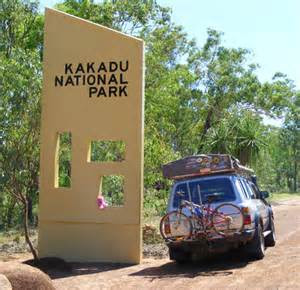 |
| Kakadu National Park |
Short Report
This unique archaeological and ethnological reserve, located in the Northern Territory, is occupied for more than 40,000 years. The cave paintings, rock carvings and archaeological sites record the skills and way of life of the inhabitants of the region, of the hunter-gatherers of prehistory to the aboriginal people still live. It is a unique example of a complex of ecosystems, including tidal flats, floodplains, lowlands and plateaus, and a habitat for a wide range of rare or endemic species of plants and animals.
Wide Report
The park consists of four large landforms: Arnhem land plateau and Llangattock escarpment complex; southern hills and basins; Koolpinyah surface; coastal plains and inland waterway transport. The western edge of the Arnhem land plateau consists of rocks, ranging in height from approximately 30-330 m over a distance of 500 km. In addition to the four large landforms, nearly 500 km2 of coastal and estuarine areas and two islands in the park. The tropical monsoonal climate, with its wet and dry seasons, is the main factor of the surface water hydrology, vegetation and, in the long term, the landforms of the park. The vegetation can be classified in 13 categories, seven of which are governed by a different kinds of Eucalyptus. Other categories consists of mangrove; samphire; lowland rainforest; paper bark swamp; seasonal floodplain and sandstone rainforest. Floristically this is the most varied and most natural surroundings of northern Australia with 46 species as rare or threatened, and nine limited to the park.
Because of the diversity of spatial systems of marine and coastal habitats (which large turtle and dugong populations) to the arid sandstone llangattock escarpment, Kakadu is one of the world's richest wildlife parks. A third of the Australian bird species and a quarter of the bathing waters and estuarine fish species are found in Kakadu. Large concentrations of waterfowl (EUR 2.5 million) seasonal use of the floodplains of the park and there is a diversity of aquatic animals, including 55 species of live and 200 species of ant (10% of the world total number) as well as a wide variety of small mammals. In addition, it contains the main breeding habitat in the world for the saltwater crocodile and the pig-nosed turtle - both endangered reptiles.
All major landforms are included in the park, that therefore provides an excellent example of both old and recent geological changes on the European mainland. The park also contains many examples of species and species that are representative of the different periods of the biological evolution of the Australian fauna. The coastal rivers and flood plains illustrate the ecological effects of sea-level change in this part of Australia, as such; the park offers a special opportunity to research to large-scale evolutionary processes in an intact landscape. The region is little affected by European settlement in comparison with the rest of the continent, hence the natural vegetation remains rich and relatively unchanged, and its faunal composition is largely intact. 300 Indigenous people living in the park, including traditional owners and aboriginal people with recognized social and traditional attachments to the area. The park contains many Aboriginal archaeological, holy and art sites.
Historical Data
The Kakadu National Park is of the highest importance, such as an extensive archaeological and ethnological reserve. The first remains of human occupation in Australia, dating from approximately 40.000 years ago, have been identified. In various locations, excavations have brought to light groups of stone tools, which, because they include the axles of polished stone, be included in the oldest in the world; further, in combination with the sites of rock carvings, workshops to prepare pigments are studied which date back at least 18,000 years.It is, of course, the aboriginal rock carvings of Kakadu which constituted the decisive argument for the title of this cultural property on the World Heritage List in 1981. on the basis of cultural Criteria I, iii and iv. These paintings, carried out in the open air, on rock walls, a long chronological span, since the oldest dating back almost 20,000 years and the latest in modern times.
For the historian, they constitute a fund of evidence of paramount importance and a source which is unique. They serve as a source of information on the primary sources, the hunting and fishing, the social structure and the ritual ceremonies of the indigenous population who succeeded on the site of Kakadu. They witnesses of missing species. As Tasmanian devils wolf and follow, in the details of the equipment and costume, the changes that have been on traditional life by the contacts that were implemented with Macao fishermen from the 16th century, and then with Europeans. For the art historian, the ensemble of paintings and icons of Kakadu is unique in so far as it combines multiple figurative and nonfigurative styles, which vary in their apparent chronology with the ensemble, recently inventoried, in southern Africa and the Sahara. The aesthetic characteristics of protest of human and animal in Arnhem Land, may also have had a negative impact on the graphic forms that appeared after 1930.
For the ethnologist, Kakadu offers a privileged research and observation, the Aboriginal People who inhabit this site contribute to continue the preservation of the balance of the ecosystem and. By traditional techniques, ensure the necessary protection for the most recent rock carvings. The social - if not the ritual - function of these preserved to some extent.
Source:whc/unesco

No comments:
Post a Comment